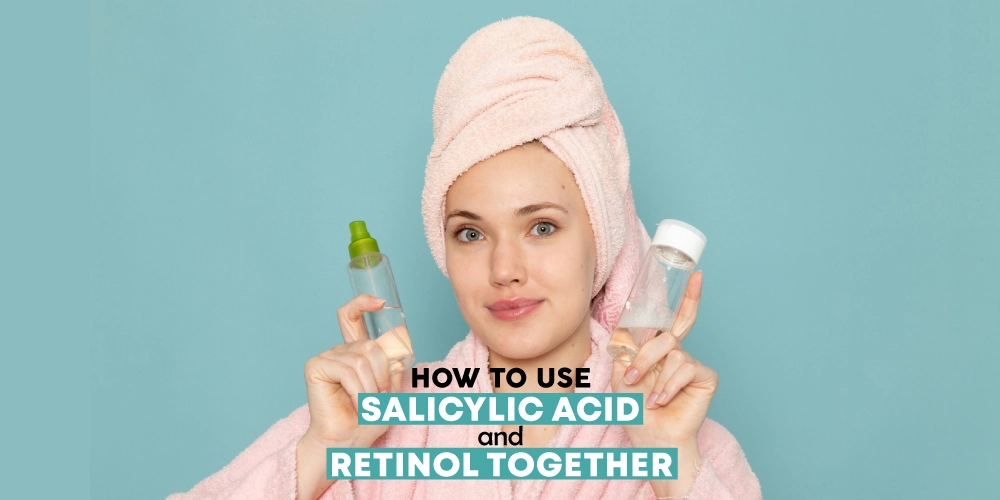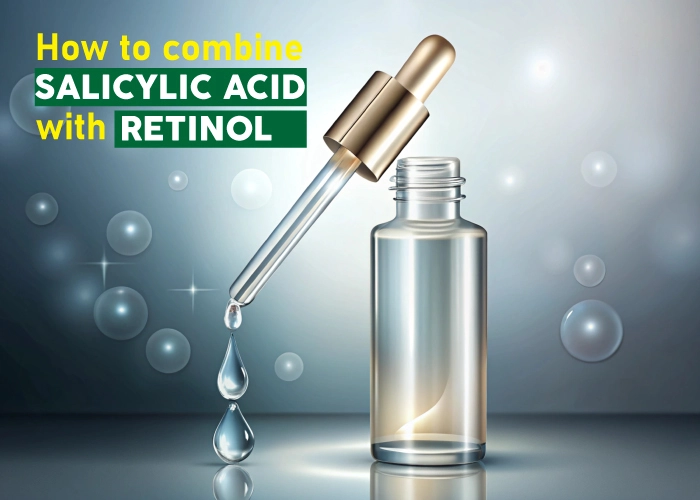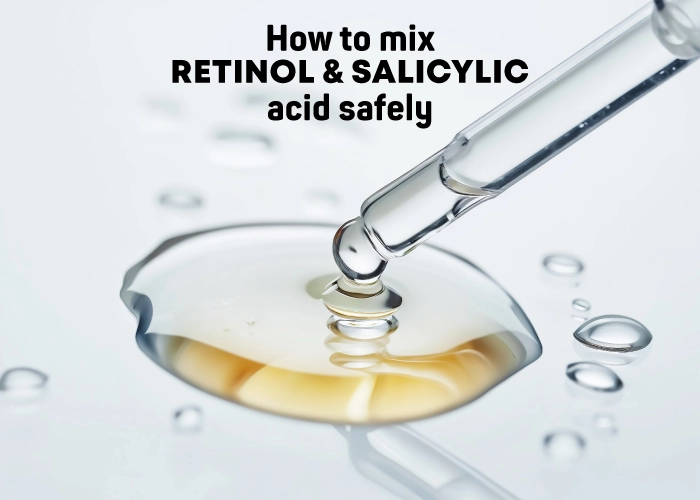It may surprise you to learn that using Retinol and Salicylic Acid together to cure breakouts and lessen the appearance of skin ageing is safe and effective,
Incorporating Retinol and salicylic acid into your skincare regimen can be quite beneficial for addressing various skin issues, such as wrinkles, acne, and clogged pores. When appropriately applied, these are vital ingredients that can help revitalise your skin, improve its texture, and increase its clarity. But if misused, they can also be annoying, so knowing how to use them together is essential. Continue reading to find out how to use salicylic acid and Retinol together.
Salicylic Acid: What Is It?
Salicylic acid is a beta hydroxy acid (BHA) that dissolves dead skin cells and excess oil by penetrating deeply into the pores. It is renowned for:
- minimising whiteheads and blackheads
- cleaning the pores to prevent acne outbreaks by exfoliating the outermost layer of skin
Retinol: What Is It?
One type of vitamin A called Retinol speeds up the turnover of skin cells to show smoother, more youthful-looking skin. It supports:
- wrinkles and fine lines
- Over Pigmentation
- enhancing the texture of the skin
Salicylic acid vs. retinol for acne
You probably want the best components in your skincare arsenal if you’re struggling with the ups and downs of adult acne: Salicylic Acid is one of acne’s worst foes, and Retinol is the gold standard for minimising the look of skin ageing, particularly the scars left behind by breakouts. Theoretically, this dynamic pair is all you need to overcome adult acne. However, when combined, typical Retinol and Salicylic Acid solutions can irritate the skin, weakening the skin’s protective layer and impeding your progress towards cleaner skin.
What skin benefits does salicylic acid offer?
Salicylic acid, the most widely used BHA, was initially made from willow tree bark. Because it is an oil-soluble exfoliator, it can dissolve dead skin cells and oils stuck in pores by penetrating your skin’s sebum.
Benefits of salicylic acid in general
- Exfoliant: removes dead skin cells
- Breaks down oil that has become stuck in pores.
- Anti-inflammatory: reduces flushing
- Antibacterial: destroys germs
- breakdown of keratin by a keratolytic
How does Retinol benefit the skin?
Retinol, a robust and water-soluble antioxidant derived from vitamin A, accelerates the process of cell turnover and promotes replacing older, dead cells with new, living ones. Less dead cell accumulation reduces the possibility of those cells obstructing your pores.
Retinol relieves several skin conditions, such as:
- Unknown
- wrinkles and fine lines
- Production of collagen
- sun-related harm
- Over Pigmentation
How to combine salicylic acid with Retinol
Conventional Retinol formulations may be incredibly erratic:
When they are exposed to light, they decompose. Moreover, they react harshly with salicylic acid on the skin. Therefore, they need to work better together. Nevertheless, we provide a unique tailored therapy at Dermalogica that combines both advantages.
Powerful components:
Oil for Retinol Clearance. Retinol Clearing Oil, which combines Retinol and Salicylic Acid for the first time, offers a comprehensive treatment for adult breakouts and ageing skin. Retinol and salicylic acid, which are formulated in a calming oil derived from plants, are gradually released as the skin is restored to health. The Retinol Clearing Oil should only be applied at night. After cleansing your face, spread 6–10 drops onto it before using a moisturiser.
It could be preferable to utilise salicylic acid and Retinol separately. If you choose this course of action, our Skin Experts advise utilising Retinol products exclusively at night and Salicylic Acid products in the morning or on different evenings from your Retinol products. Using Dynamic Skin Retinol Serum as your nighttime serum and Clearing Skin Wash as your morning cleanser would be an excellent combination for this method.
How about combining Glycolic Acid and Retinol?
The same guidelines must be followed when using other hydroxy acids with Retinol: avoid overstimulating the skin, and do not use them together if they are not precisely made together in one sitting. Since glycolic acid is the most vital hydroxy acid, it is generally not recommended to combine it with Retinol. Once more, you can switch, either in the morning and evening or on different days.
Glycolic acid and Retinol are known to increase collagen formation and cell renewal; therefore, combining these active ingredients may help you combat skin ageing more effectively. Try using Liquid Peel Exfoliant a few times a week and Dynamic Skin Retinol Serum in the evenings. You don’t use Liquid Peel Exfoliant if you have tough skin and are an informed skincare consumer. Brighter, firmer skin will greet you once you bid adieu to wrinkles, fine lines, and uneven skin tone!
Liquid Peelfoliant is made with a potent combination of acids and enzymes that target various layers of the skin’s surface, such as 0.5% salicylic acid and a 10% mixture of lactic and glycolic acids.
How to mix Retinol and salicylic acid safely
It’s important to use caution when combining strong acne-fighting chemicals, but retinol and salicylic acid combined are entirely safe and can work wonders. Salicylic acid exfoliation can increase Retinol’s effectiveness by allowing it to penetrate the skin’s deeper layers. This is a detailed skincare regimen:
Daily schedule in the morning
- Use a mild cleanser that contains BHA to clean your face, such as SLMD Salicylic Acid Cleanser. This is mild to use daily and is designed for all skin types.
- Apply a mild moisturiser and a broad-spectrum sunscreen with a minimum SPF of 15 afterwards.
Evening schedule
- Wash your face to get rid of pollutants.
- Apply a retinol product with a time-release formula that contains hyaluronic acid and skin-soothing ingredients, like SLMD Retinol Serum.
Who Must Steer Clear of This Combination?
This mixture may be too intense for susceptible skin or prone to rosacea. Before incorporating both ingredients into your routine, get advice from a dermatologist.
Is it necessary to use sunscreen when taking salicylic acid and Retinol?
Last but not least, always apply sunscreen since hydroxy acids like salicylic acid and Retinol can make your skin more sensitive to the sun. Replace your existing sunscreen with a physical or mineral-based one, like Invisible Physical Defence SPF 30, if it produces too much heat.
Last Words
Salicylic acid and Retinol, when appropriately used, can be a powerful combination for curing acne, enhancing skin texture, and minimising ageing symptoms. Prioritise sun protection and hydration at all times; start cautiously and monitor how your skin responds. You’ll be well on your way to a more radiant, smoother complexion with patience and care!



